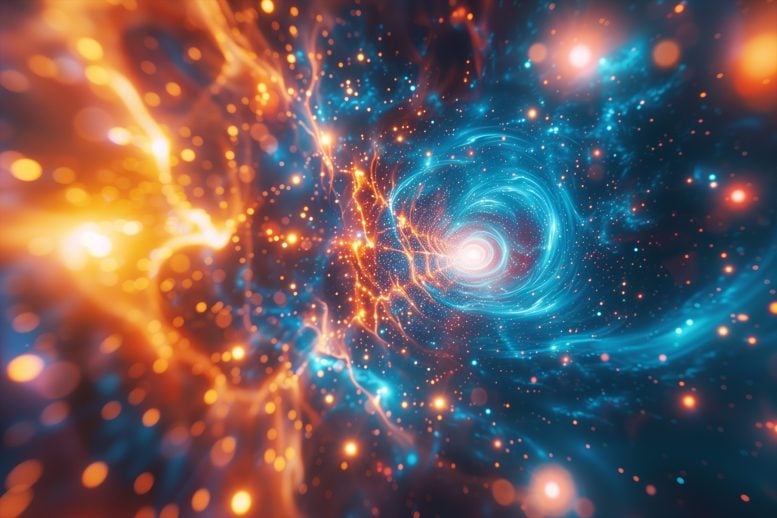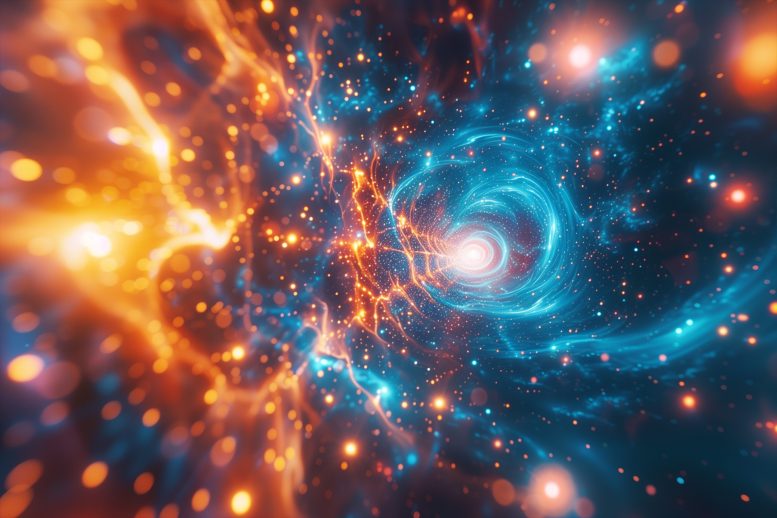

Researchers have utilized the Grüneisen parameter in studying the universe’s expansion, linking thermodynamics with cosmology. Their findings suggest the universe’s continuous cooling is related to its adiabatic expansion, and the potential variability of the cosmological constant challenges traditional models. Credit: SciTechDaily.com
The shift from a decelerating expansion regime (in the radiation- and matter-dominated era) to an accelerating expansion regime (in the dark energy-dominated era) resembles a thermodynamic phase transition, according to an article in Results in Physics by scientists affiliated with São Paulo State University.
The idea that the Universe is expanding dates from almost a century ago. It was first put forward by Belgian cosmologist Georges Lemaître (1894-1966) in 1927 and confirmed observationally by American astronomer Edwin Hubble (1889-1953) two years later. Hubble observed that the redshift in the electromagnetic spectrum of the light received from celestial objects was directly proportional to their distance from Earth, which meant that bodies farther away from Earth were moving away faster and the universe must be expanding.
Discovery of Accelerating Expansion
A surprising new ingredient was added to the model in 1998 when observations of very distant supernovae by the Supernova Cosmology Project and the High-Z Supernova Search Team showed that the Universe is accelerating as it expands, rather than being slowed down by gravitational forces, as had been supposed. This discovery led to the concept of dark energy, which is thought to account for more than 68% of all the energy in the currently observable Universe, while dark matter and ordinary matter account for about 27% and 5% respectively.


Representations of universe eras – (a) radiation, (b) matter, (c) dark energy – with the respective values of the equation of state ω = Γeff, where Γeff is the effective Grüneisen parameter. As dark energy becomes dominant, Γeff changes sign and emulates a phase transition in condensed matter physics. Credit: Results in Physics
Application of Thermodynamics in Cosmology
“Measurements of redshift suggest that the accelerating expansion is adiabatic [without heat transfer] and anisotropic [varying in magnitude when measured in different directions],” said Mariano de Souza, a professor in the Department of Physics at São Paulo State University (UNESP) in Rio Claro, Brazil. “Fundamental concepts in thermodynamics allow us to infer that adiabatic expansion is always accompanied by cooling due to the barocaloric effect [pressure-induced thermal change], which is quantified by the Grüneisen ratio [Γ, gamma].”
In 1908, German physicist Eduard August Grüneisen (1877-1949) proposed a mathematical expression for Γeff, the effective Grüneisen parameter, an important quantity in geophysics that often occurs in equations describing the thermoelastic behavior of material. It combines three physical properties: expansion coefficient, specific heat, and isothermal compressibility. Almost a century later, in 2003, Lijun Zhu and collaborators demonstrated that a specific part of the Grüneisen parameter called the Grüneisen ratio, defined as the ratio of thermal expansion to specific heat, increases significantly in the vicinity of a quantum critical point owing to the accumulation of entropy. In 2010, Souza and two German collaborators showed that the same thing happens near a finite-temperature critical point.
Recent Research Using the Grüneisen Parameter
Now Souza and fellow researchers at UNESP have used the Grüneisen parameter to describe intricate aspects of the expansion of the Universe in an article published in the journal Results in Physics, presenting part of the PhD research of first author Lucas Squillante, currently a postdoctoral fellow under Souza’s supervision.
“The dynamics associated with the expansion of the Universe are generally modeled as a perfect fluid whose equation of state is ω = p/ρ, where ω [omega] is the equation of state parameter, p is pressure, and ρ [rho] is energy density. Although ω is widely used, its physical meaning hadn’t yet been appropriately discussed. It was treated as merely a constant for each era of the Universe. One of the important results of our research is the identification of ω with the effective Grüneisen parameter by means of the Mie-Grüneisen equation of state,” Souza said. The Mie–Grüneisen equation of state relates to pressure, volume and temperature, and is often used to determine the pressure in a shock-compressed solid.
Thermodynamics and the Anisotropic Expansion of the Universe
The authors show, using the Grüneisen parameter, that continuous cooling of the Universe is associated with a barocaloric effect that relates pressure and temperature and occurs owing to adiabatic expansion of the Universe. On this basis, they propose that the Grüneisen parameter is time-dependent in the dark energy-dominated era (the current universe era).
One of the interesting aspects of this research is its use of thermodynamics and solid-state physics concepts such as stress and strain to describe the anisotropic expansion of the Universe. “We show that the Grüneisen parameter is naturally embodied in the energy–momentum stress tensor in Einstein’s famous field equations, opening up a novel way to investigate anisotropic effects associated with the expansion of the Universe. These don’t rule out the possibility of a Big Rip,” Souza said.
The Big Rip hypothesis, first put forward in 2003 in an article published in Physical Review Letters, posits that if the quantity of dark energy is sufficient to accelerate the expansion of the Universe beyond a critical velocity, this could tear the “fabric” of space-time and rip apart the Universe.
Dark Energy and Theoretical Implications
“Also in the perspective of the Grüneisen parameter, we conjecture that the shift from a decelerating expansion regime [in the radiation and matter-dominated eras] to an accelerating expansion regime [in the dark energy-dominated era] resembles a thermodynamic phase transition. This is because Γeff changes sign when the expansion changes from decelerating to accelerating. The sign change resembles the typical signature of phase transitions in condensed matter physics,” Souza said.
Dark energy is often associated with the cosmological constant Λ [lambda], originally introduced by Einstein in 1917 as a repulsive force required to keep the Universe in static equilibrium. Einstein later rejected the concept, according to some accounts. It was rehabilitated when the expansion of the Universe was found to be accelerating instead of decelerating. The hegemonic model, known as Λ-CMD (Lambda-Cold Dark Matter), gives the cosmological constant a fixed value. That is, it assumes that the density of dark energy remains constant as the Universe expands. However, other models assume that the density of dark energy, and hence Λ, vary over time.
“Assigning a fixed value to lambda means also assigning a fixed value to omega, but recognition of ω as the effective Grüneisen parameter enables us to infer time dependency for ω as the Universe expands in the dark energy-dominated era. This directly entails time dependency for Λ, or the universal gravitation constant,” Souza said.
The study could lead to important developments insofar as it affords a glimpse of a novel interpretation of the expansion of the Universe in terms of thermodynamics and condensed matter physics.
Reference: “Exploring the expansion of the universe using the Grüneisen parameter” by Lucas Squillante, Gabriel O. Gomes, Isys F. Mello, Guilherme Nogueira, Antonio C. Seridonio, Roberto E. Lagos-Monaco and Mariano de Souza, 17 January 2024, Results in Physics.
DOI: 10.1016/j.rinp.2024.107344
Besides Souza and Squillante, the other co-authors of the article are Antonio Seridonio (UNESP Ilha Solteira), Roberto Lagos-Monaco (UNESP Rio Claro), Gabriel Gomes (Institute of Astronomy, Geophysics and Atmospheric Sciences, University of São Paulo, IAG-USP), Guilherme Nogueira (UNESP Rio Claro), and PhD candidate Isys Mello, supervised by Souza.
The study was supported by FAPESP via two projects (11/22050-4 and 18/09413-0).
